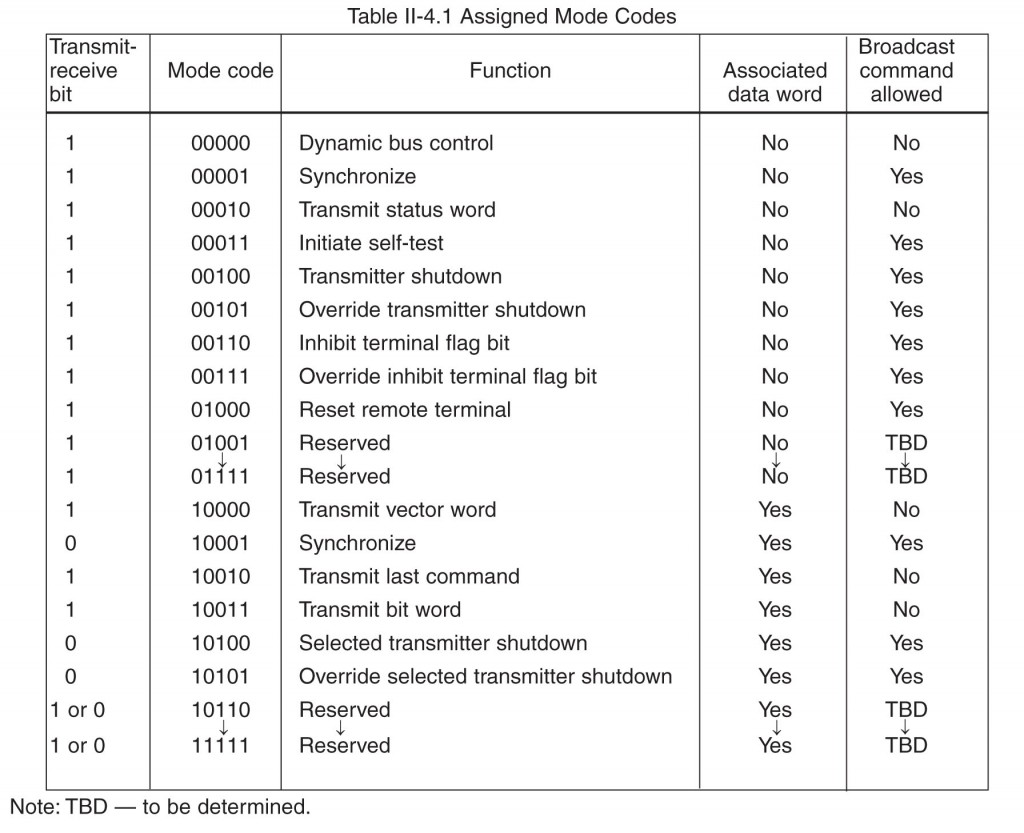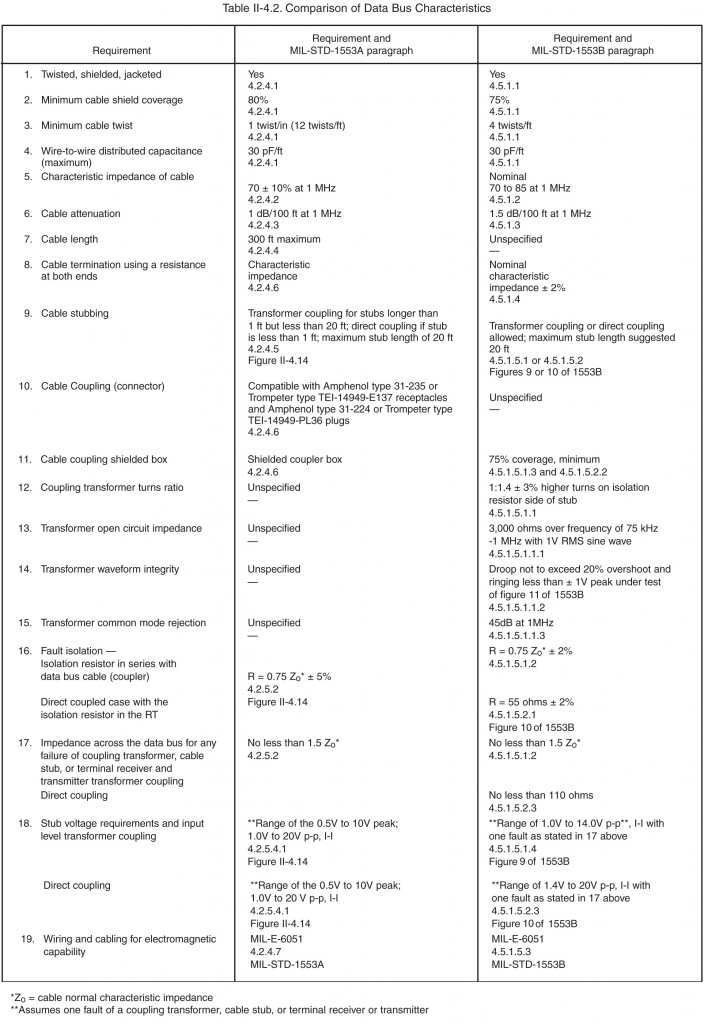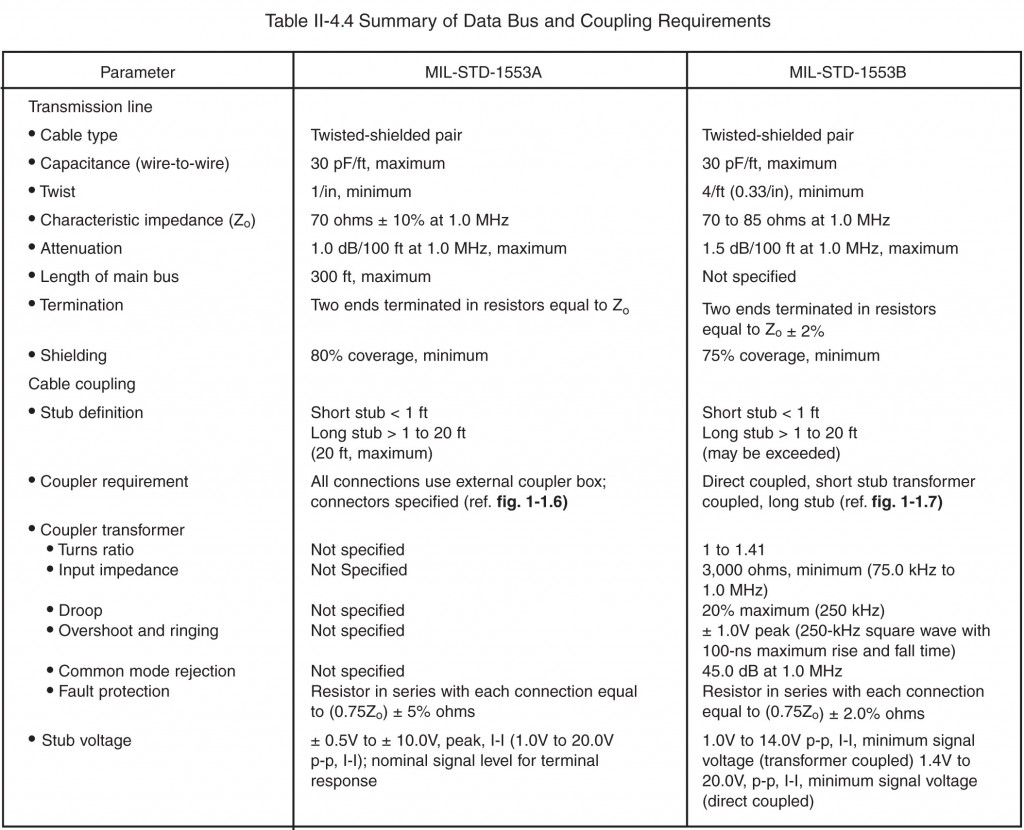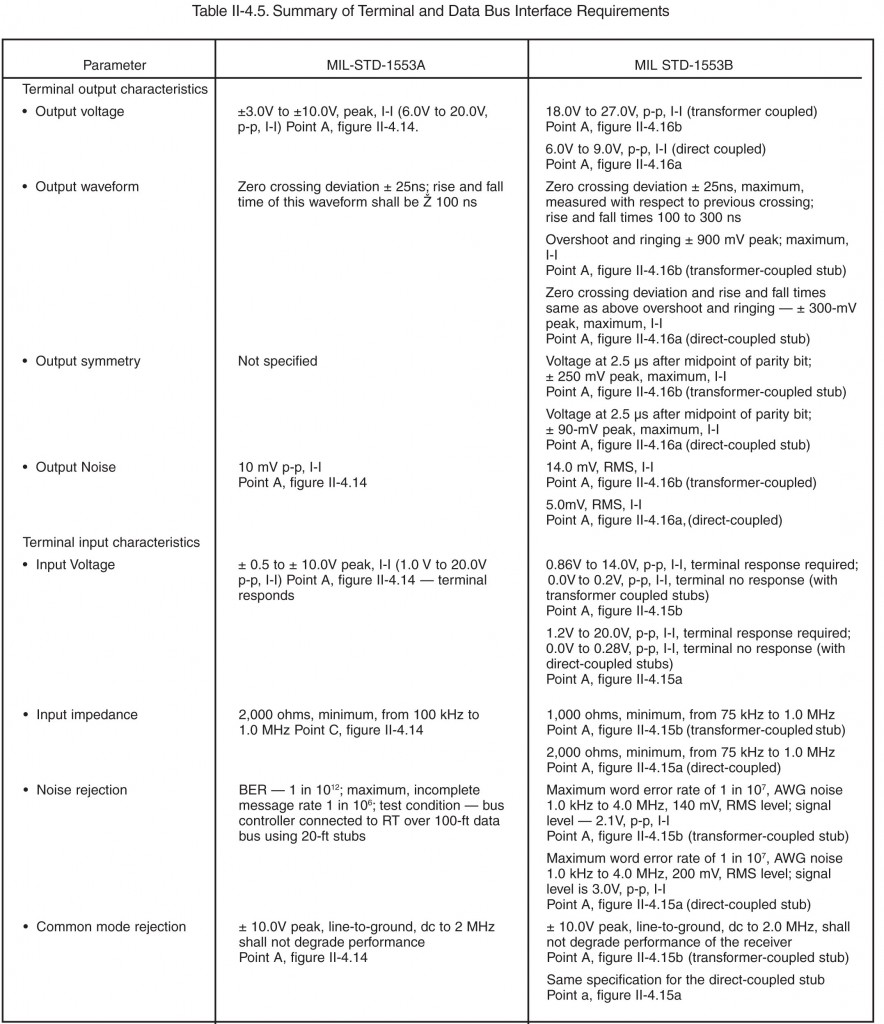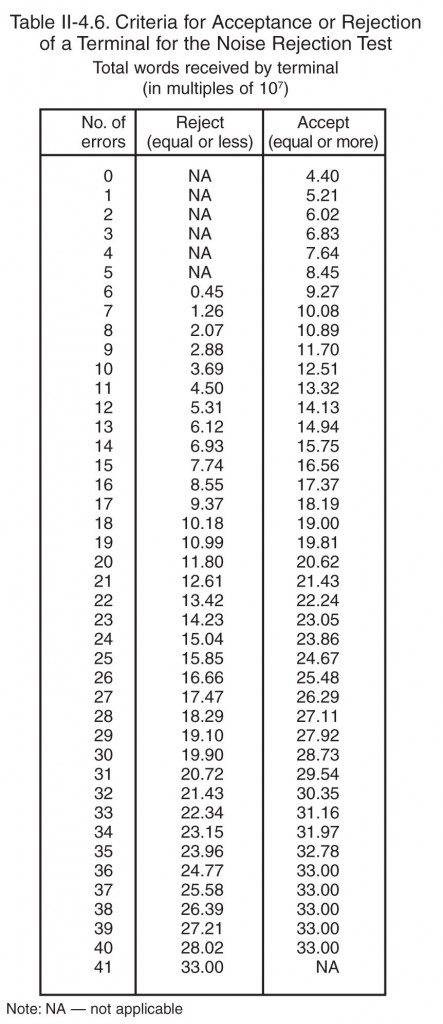Several paragraphs have been added, changed, and renumbered in the requirements section of 1553B compared to 1553A.
4.1 Test and Operating Requirements
This new paragraph of the 1553B was added to indicate that the performance requirements specified in this standard shall apply over the environmental conditions in which the multiplex data bus system shall be required to operate. It is anticipated that for most military applications this will be described by MIL-E-5400 Class II and ‘some nuclear-hardening specifications. Because of the diversity of environmental conditions, the standard does not specify these requirements. Therefore, the system designer must determine, from appropriate vehicles or system specifications, the environmental conditions imposed on the multiplex data bus system.
4.2 Data Bus Operation
This paragraph is identical to paragraph 4.1 in 1553A with the exclusion of the reference to electromagnetic compatibility, which appears in paragraph 4.5.1.1.5.3 of 1553B.
4.3 Characteristics - Part 1
4.3.1 Data Form
Digital data may be transmitted in any desired form, provided that the chosen form shall be compatible with the message and word formats defined in this standard. Any unused bit positions in a word shall be transmitted as logic zeroes.
4.3.2 Bit Priority
The most significant bit shall be transmitted first with the less significant bits following in descending order of value in the data word. The number of bits required to define a quantity shall be consistent with the resolution or accuracy required. In the event that multiple precision quantities (information accuracy or resolution requiring more than 16 bits) are transmitted, the most significant bits shall be transmitted first, followed by the word(s) containing the lesser significant bits in numerical descending order. Bit packing of multiple quantities in a single data word is permitted.
This paragraph is identical to paragraph 4.2 in 1553A with the additional capability in paragraph 4.3.2 of 1553B concerning bit-packing of multiple quantities.
Bit-packing is a method used to improve transmission efficiency when subsystem data, which contain less than 16 bits of information per parameter (word), are collected and distributed in one word or message. Single-bit data and other parameters that are characterized by bit patterns of fewer than 16 bits will not fill the 16 bits of data allowed in 1553 data word format. Two approaches are used to utilize all bits in a word: (1) packing multiple parameters and words and (2) filling in zeros for all unused bits. In the first approach, the encoding and decoding cost must be considered, while in the second approach the inefficiency of sending as little as one bit per word must be considered.
4.3.3 Transmission Method
4.3.3.1 Modulation
The signal shall be transferred over the data bus in serial digital pulse code modulation form.
This paragraph remained unchanged in both revisions of the standard.
4.3.3.2 Data Code
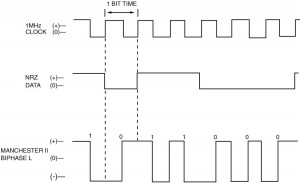
The data code shall be Manchester II biphase level. A logic one shall be transmitted as a bipolar coded signal 1/0 (i.e., a positive pulse followed by a negative pulse). A logic zero shall be a bipolar coded signal 0/1 (i.e., a negative pulse followed by a positive pulse). A transition through zero occurs at the midpoint of each bit time (see figure 2).
This paragraph remained unchanged in both revisions of the standard.
4.3.3.3 Transmission Bit Rate
The transmission bit rate on the bus shall be 1.0 megabit per second with a combined accuracy and long-term stability of ± 0.1 percent(i.e., ± 1000 Hz).The short term stability (i.e., stability over 1.0 second interval) shall be at least 0.01 percent (i.e., ± 100 Hz).
The long- and short-term stability of the individual internal clocks used to transmit encoded data have been relaxed in 1553B. The order of magnitude reduction in transmission bit rate stability allows for the selection of multiplex bus interface clocks that can meet long-shelf-life requirements of some weapons.
4.3.3.4 Word Size
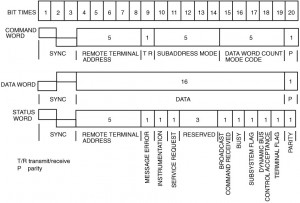
The word size shall be 16 bits plus the sync waveform and the parity bit for a total of 20 bits times as shown on figure 3.
The 20-bit word size was selected because it represented the minimum number of bits in a word, when 16 bits of data, a three-bit invalid Manchester sync pattern, and a single parity bit are used. Except for paragraph changes of 4.2.3.4 (1553A) to 4.3.3.4 (1553B) this paragraph remained unchanged. Three-bit invalid Manchester sync pattern is described in 1553B, paragraph 4.3.3.5.1.1 Figure 3 (referenced in this paragraph) is modified in 1553B to reflect the identification of status codes.
4.3.3.5 Word Formats
The word formats shall be as shown on figure 3 for the command, data, and status words.
Three types of word formats were selected to operate the information transfer system. Each format and the changes reflected in 1553B will be discussed in the following paragraphs.
4.3.3.5.1 Command Word
A command word shall be comprised of a sync waveform, remote terminal address field, transmit/receive (T/R) bit, subaddress/mode field, word count/mode code field, and a parity (P) bit (see figure 3).
The command word format is used to control and manage the information transfer system. Two basic additions were made to the command word by 1553B. These include the broadcast mode and the identification of the optional mode codes.
4.3.3.5.1.1 Sync
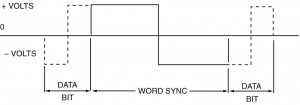
The command sync waveform shall be an invalid Manchester waveform as shown on figure 4. The width shall be three bit times, with the sync waveform being positive for the first one and one-half bit times, and then negative for the following one and one-half bit times. If the next bit following the sync waveform is a logic zero, then the last half of the sync controller
waveform will have an apparent width of two clock periods due to the Manchester encoding.
The sync pattern used in the standard remained unchanged.
4.3.3.5.1.2 Remote Terminal Address
The next five bits following the sync shall be the RT address. Each RT shall be assigned a unique address. Decimal address 31 (11111) shall not be assigned as a unique address. In addition to its unique address, a RT shall be assigned decimal address 31 (11111) as the common address, if the broadcast option is used.
Each remote terminal will be assigned a unique address for which it is responsible to respond when the address is transmitted as part of a command word on the data bus by the active bus controller. Only one remote terminal address cannot be assigned as a unique address (decimal address 31). This address has been assigned to all remote terminals as the common address for which they will receive broadcasted data if the system uses the broadcast option.
The broadcast mode provides a mechanism for transmitting information to multiple users with a single message. The mechanism for accomplishing this was to dedicate address 31 (11111) to be reserved for broadcast messages. Anytime a broadcast message is transmitted, the transmitting terminal will use address 31 rather than a unique terminal address. All other addresses can be assigned as in 1553A. Since multiple sets of broadcast messages can be responding status word must be suppressed. By choosing the address method to accomplish the broadcast mode, all the other formats of the command word are available for use. Broadcast messages can be used with subaddresses and mode codes. The subaddress in a broadcast message can allow multiple users with broadcast reception capability to sort our specific broadcast messages transmitted, if given this capability in hardware or software. Therefore, multiple sets of broadcast messages can be defined. In addition, the broadcast format can be used with mode codes. This allows simultaneous transmission of mode commands to users.
Indiscriminate use of the broadcast technique is not advisable. Designers must question the benefit of discarding the command/response format, in which all message completion failures are know to the bus controller, to the benefits described below. Broadcast use may increase system operation complexity since subaddresses of broadcast address and addressed terminal will not likely be the same. This requires additional subaddresses. Finally, the broadcast technique, if used, adds a failure mode to the system if a terminal in a failure mode used address 31 for a message. Proper use of the broadcast mode may yield several benefits:
- Multiple terminals can be communicated with simultaneously, thereby permitting time synchronization of data or commands.
- Bus duty cycle can be reduced by transmitting data required by multiple users simultaneously instead of sequentially.
- Some error management can be enhanced by providing a single address by which all terminals can receive commands simultaneously. This permits the bus controller to immediately command a state for the system rather than polling each unit individually with the same command in a serial fashion.
The broadcast message capability can produce considerable reduction in bus usage. This is particularly true for systems using multiple units for redundancy or systems dependent on parallel processing, thus requiring simultaneous data arrival at the processing units. As noted in 1553B, paragraph 10.6 (appendix to 1553B), improper use of the broadcast format can result in undesirable system operation. Since no status word response is allowed from the receiving terminal, discretion must be exercised when applying the capability. To provide message arrival verification, a bit in the status word is set when a valid broadcast message is received. This allows reporting of the reception if requested by the active bus controller using the mode code “transmit status word.” In error situations, it may be advisable for the bus controller to request the last command word to verify that the broadcast command was received. There may be situations for which rebroadcast cannot be permitted. Asking for last command first preserves the last status word (i.e., the terminal does not reset or update status). In addition to data transfers, the ability to transmit a broadcast command message provides an effective method for managing the data bus system. This capability is performed using the broadcast address in combination with mode commands.
4.3 Characteristics - Part 2
4.3.3.5.1.3 Transmit/Receive
The next bit following the remote terminal address shall be the T/R bit, which shall indicate the action required of the RT. A logic zero shall indicate the RT is to receive, and a logic one shall indicate the RT is to transmit.
The transmit/receive bit in the command word indicates the source of data flow in the information transfer system. Basically, the paragraph remained unchanged for both revisions of the standard except for wording changes and paragraph numbering differences.
4.3.3.5.1.4 Subaddress/Mode
The next five bits following the T/R bit shall be utilized to indicate an RT subaddress or use of mode control, as is dictated by the individual terminal requirements. The subaddress/mode values of 00000 and 11111 are reserved for special purposes, as specified in 4.3.3.5.1.7, and shall not be utilized for any other function.
This field has two functions: (1) the subaddress identification of specific messages to a remote terminal and (2) reserved subaddresses that serve as the identification that a mode command to the information transfer system is being transmitted. Both of these capabilities were present in 1553A. However, an additional mode code designator has been established in 1553B (decimal 31). The use of either 00000 or 11111 in the subaddress/mode field will be decoded to indicate that a mode code command is present in the next five-bit field. This limits the subaddress range to a maximum of 30 unique addresses. If the instrumentation bit (par. 4.3.3.5.3) in the status word is implemented, the subaddresses will be limited to 15 unique subaddresses. The requirements for use of the instrumentation bit are in 1553B, paragraph 4.3.3.5.3.4 In complex remote terminals (i.e., terminals interfacing with several sensors or multiple interface types), the subaddress capacity of a terminal can be exceeded. In addition, messages to a given remote terminal-subaddress may contain “packed” data requiring additional decoding prior to distribution within the terminal. Both of these conditions can cause the remote terminal’s design to incorporate a map (i.e., look-up table) approach for subaddress message distribution.
4.3.3.5.1.5 Data Word Count/Mode Code
The next five bits following the subaddress/mode control shall be the quantity of data words to be either sent out or received by the RT or the optional mode code as specified in 4.3.3.5.1.7. A maximum of 32 data words may be transmitted or received in any one message block. All 1’s shall indicate a decimal count of 31, and all 0’s shall indicate a decimal count of 32.
The dual function of this field provides for the identification of message lengths for data message or mode codes for managing the information transfer system. The identification of both of these capabilities was provided in 1553B but only the word count was specified in 1553A (even though the mode code function has remained the same in both revisions). The five-bit field allows 32 data words to be transmitted in a message or 32 specific mode codes. This is accomplished by one data word being represented as 00001, and all zeros being arbitrarily defined as decimal 32
4.3.3.5.1.6 Parity
The last bit in the word shall be used for parity over the preceding 16 bits. Odd parity shall be utilized.
The use of a single parity bit per word was provided to identify bit errors occurring during the transmission and detection of a word. According to the statement in the appendix to 1553B, “Theoretical and empirical evidence indicates than an undetected bit error rate of 10 -12 can be expected from a practical multiplex system built to this standard.” See 1553B, paragraph 10.4. Also see noise test in 1553B, paragraph 4.5.2.1.2.4. This paragraph remained unchanged during both revisions.
4.3.3.5.1.7 Optional Mode Control
For RT’s exercising this option a subaddress/mode code of 00000 or 11111 shall imply that the contents of the word count field are to be decoded as a five bit mode command. The mode code shall only be used to communicate with the multiplex bus related hardware, and to assist in the management of information flow, and not to extract data from or feed data to a functional subsystem. Codes 00000 through 01111 shall only be used for mode codes which do not require transfer of a data word. For these codes, the T/R bit shall be set to 1. Codes 10000 through 11111 shall only be used for mode codes which require transfer of a single data word. For these mode codes, the T/R bit shall indicate the direction of data word flow as specified in 4.3.3.5.1.3. No multiple data word transfer shall be implemented with any mode code. The mode codes are reserved for the specific functions as specified in table II-4.1 and shall not be used for any other purposes. If the designer chooses to implement any of these functions, the specific codes, T/R bit assignments, and use of a data word, shall be used as indicated. The use of the broadcast command option shall only be applied to particular mode codes as specified in table II-4.1.
The basic philosophy of the information transfer system is that it operates as a transparent communication link. “Transparent” means that an application’s function does not need to be involved with the management of communication control. Obviously, the information transfer system requires management that introduces overhead into the transmission of data. The command words, status words, status word gaps, and message gaps are the overhead. Within the command word the mode codes provide data bus management capability. The mode codes have been divided into two groups: mode codes without a data word (00000-01111) and mode codes with a data word (10000-11111). The use of bit 15 in the command word to identify the two types was provided to aid in the decoding process. Also, the use of a single data word instead of multiple data words was adopted to simplify the mode circuitry. Generally, with these two types of mode commands, all management requirements of an information transfer system can be met.
Control messages are identified by the subaddress/mode field in the command word being set to 32(00000)or 31 (11111). (In this case, 1553B defines decimal subaddress 32 to be equal to binary 00000 so that decimal 1 through decimal 31 correspond to binary 00001 through 11111.) All control messages originate with the active bus controller and are received by a single receiver or by multiple receivers (broadcast). A terminal address value of 31 (11111) in the command word indicates a broadcast message, while any other terminal addresses are to identify unique messages to a terminal on the bus. The mode command information is contained completely in the mode code/word field of the command word.
Table II-4.1 should be examined carefully to see the symmetry of the mode codes. The first 16 codes are not transmitted with a data word; the last 16 are. It is not appropriate to broadcast some of the mode codes because of the possibility of bus crashes — simultaneous transmission by two or more terminals. Examples are requests for transmissions from RTs. Also, broadcast of dynamic bus control makes no sense. The T/R bit is important for mode codes 17 to 31 because it defines whether bus controller or RT is to transmit the associated data word.
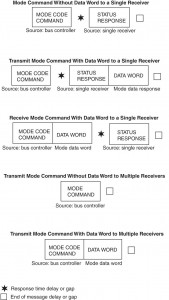
The use of mode commands option is defined in both versions of the standard; however, 1553B defines each mode command while 1553A only defines dynamic bus control. There is no particular reason for the assignment of the mode codes, except for dynamic bus control (00000), which was previously defined in 1553A and this separation of mode command by the use of a data word. The purpose of reserved mode commands in each category (with and without data words) is important to allow for controlled expansion of the standard. By controlling the mode code command number and its definition, commonality between various terminal can be maintained. Each mode code command identification is listed in 1553B table II-4.1. All other mode codes are considered illegal commands. The message formats associated with mode commands are shown in figure II-4.1.
4.3.3.5.1.7.1 Dynamic Bus Control
The controller shall issue a transmit command to an RT capable of performing the bus control function. This RT shall respond with a status word as specified in 4.3.3.5.3. Control of the data bus passes from the offering bus controller to the accepting RT upon completion of the transmission of the status word by the RT. If the RT rejects control of the data bus, the offering bus controller retains control of the data bus.
The dynamic bus control mode command (00000) is provided to allow the active bus controller a mechanism (using the information transfer system message formats) to offer a potential bus controller (operating as a remote terminal) control of the data bus. Only the single receiver command request (unique address) is allowed to be issued by the active bus controller. The response to this offering of bus controller is provided by the receiving remote terminal using the dynamic bus control acceptance bit in the status word (par. 4.3.3.5.3). Rejection of this request by the remote terminal requires the presently active bus controller to continue offering control to other potential controllers or remain in control. When a remote terminal accepts control of the data bus system by setting the dynamic bus control acceptance bit in the status word, control is relinquished by the presently active bus controller, and the potential bus controller begins bus control.
Note that the sequence above requires software (or firmware) implementation in all bus controllers.
4.3.3.5.1.7.2 Synchronize (Without Data Word)
This command shall cause the RT to synchronize (e.g., to reset the internal timer, to start a sequence, etc.) The RT shall transmit the status word as specified in 4.3.3.5.3.
4.3 Characteristics - Part 3
4.3.3.5.1.7.3 Transmit Status Word
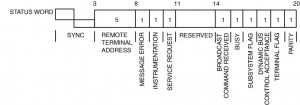
This command shall cause the RT to transmit the status word associated with the last valid command word preceding this command. This mode command shall not alter the state of the status word.
The status word associated with mode code (00010) is shown in figure II-4.2 and contains the following information:
- Transmitting terminal address
- Message error bit
- Instrumentation bit
- Service request bit
- Broadcast command receive bit
- Busy bit
- Subsystem flag bit
- Terminal flag bit
Details concerning the usage of the status bits are discussed in 1553B, paragraph 4.3.3.5.3. The only message format for acquiring the status word using this mode code is for the bus controller to request the status word from a single receiver. Note that use of this mode code by the bus controller causes the last status word to be transmitted. Some subtle conditions need to be examined by the designer who uses this mode command. For example, if the transmit built-in test mode command is needed to verify the terminal is operational, that request (see 4.3.3.5.1.7.14) must be issued after the transmit status word mode code to prevent loss of the previous message’s status.
4.3.3.5.1.7.4 Initiate Self Test
This command shall be used to initiate self test within the RT. The RT shall transmit the status as specified in 4.3.3.5.3.
The initiate self-test mode command (00011) is provided to initiate built-in-test (BIT) circuitry within remote terminals. The mode code is usually followed, after sufficient time for test completion, by a transmit BIT word mode command yielding the results of the test. The message formats provided for this mode command allow for both individual requests and multiple requests. Notice that the initiate self-test mode command is associated with the multiplex system terminal hardware only.
4.3.3.5.1.7.5 Transmitter Shutdown
This command (to only be used with dual redundant bus systems) shall cause the RT to disable the transmitter associated with the redundant bus. The RT shall not comply with a command to shut down a transmitter on the bus from which this command is received. In all cases, the RT shall respond with a status word as specified in 4.3.3.5.3. after this command.
4.3.3.5.1.7.6 Override Transmitter Shutdown
This command (to be used only with dual redundant bus system) shall cause the RT to enable a transmitter which was previously disabled. The RT shall not comply with a command to enable a transmitter on the bus from which this command is received. In all cases, the RT shall respond with a status word as specified in 4.3.3.5.3 after this command.
4.3.3.5.1.7.7 Inhibit Terminal Flag (T/F) Bit
This command shall cause the RT to set the T/F bit in the status word specified in 4.3.3.5.3 to logic zero until otherwise commanded. The RT shall transmit the status word as specified in 4.3.3.5.3.
The inhibit terminal flag mode code (00110) is used to set the terminal flag bit in the status word to an unfailed condition regardless of the actual state of the terminal being addressed. This mode code is primarily used to prevent continued interrupts to the error handling and recovery system when the failure has been noted and the system reconfigured as required. Commanding this mode code prevents future failures from being reported, which normally would be reported using the terminal flag in each subsequent status word response. The message format associated with the mode code allows for both single receivers and multiple receivers to respond. No data word is required with this mode code. Note that the terminal flag, which is used to indicate an RT fault condition is implicitly limited to terminal faults.
4.3.3.5.1.7.8 Override Inhibit T/F Bit
This command shall cause the RT to override the inhibit T/F bit specified in 4.3 3.51.7.7. The RT shall transmit the status word as specified in 4.3.3.5.3.
The override inhibit T/F flag mode command (00111) negates the inhibit function thus allowing the T/F flag bit in the status response to report present condition of the terminal. This mode code can be transmitted by the active bus controller to both single and multiple receivers. There is no data word associated with this mode code.
4.3.3.5.1.7.9 Reset Remote Terminal
This command shall be used to reset the RT to a power up initialized state. The RT shall first transmit its status word, and then reset.
The reset remote terminal mode code (01000) causes the addressed terminal to reset itself to a power-up initialized state. This mode code may be transmitted to an individual or to multiple terminals.
4.3.3.5.1.7.10 Reserved Mode Codes (01001 to 01111)
These mode codes are reserved for future use and shall not be used.
4.3.3.5.1.7.11 Transmit Vector Word
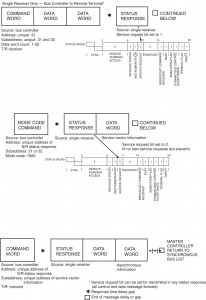
This command shall cause the RT to transmit a status word as specified in 4.3.3 5.3 and a data word containing service request information
The transmit vector word mode code (10000) is associated with the service request bit in the status word and is used to determine specific service being required by the terminal. The service request bit and the transmit vector word provide the only means available for the terminal to request the scheduling of an asynchronous message if more than one service request exists per terminal. The message format for this single receiver operation contains a data word associated with the terminal’s response. Figure II-4.3 illustrates the message formats associated with this mode command.
4.3 Characteristics - Part 4
4.3.3.5.1.7.12 Synchronize (With Data Word)
The RT shall receive a command word followed by data word as specified in 4.3.3.5.2. The data word shall contain synchronization information for the RT. After receiving the command and data word, the RT shall transmit the status word as specified in 4.3.3.5.3.
Synchronization informs the terminal(s) of an event time to allow coordination between the active bus controller and receiving terminals. Synchronization information may be implicit in the command word (mode code 00001) or a data word (mode code 10001) may be used to follow the command word to provide the synchronization information. /f a data word is used, the definition of the bit meanings is the responsibility of the system designer.
4.3.3.5.1.7.13 Transmit Last Command Word
This command shall cause the RT to transmit its status word as specified in 4 3.3 5.3 followed by a single data word which contains bits 4-19 of the last command word, excluding a transmit last command word mode code received by the RT This mode command shall not alter the state of the RT’s status word.
The transmit last command mode code (10010) is used in the error handling and recovery process to determine the last valid command received by the terminal, except for this mode code. Also this mode code will not change the state of the status word. The message format associated with the single receiver last command word contains a data word from the responding terminal. The data word contains the previous 16 bits of the last valid command word received. Notice that this mode command will not alter the state of the receiving terminals status word. This fact allows this mode command to be used in error handling and recovery operation without affecting the status word, which can have added error data.
4.3.3.5.1.7.14 Transmit Built-In-Test (BIT) Word
This command shall cause the RT to transmit its status word as specified in 4.3.3.5.3 followed by a single data word containing the RT BIT data. This function is intended to supplement the available bits in the status words when the RT hardware is sufficiently complex to warrant its use. The data word, containing the RT BIT data, shall not be altered by the reception of a transmit last command or a transmit status word mode code. This function shall not be used to convey BIT data from the associated subsystem(s).
The transmit BIT word mode command (10011) provides the BIT results available from a terminal, as well as the status word. Typical BIT word information for both embedded and standalone remote terminals includes encoder-decoder failure analog T/R failures, terminal control circuitry failures, power failures, subsystem interface failures, and protocol errors (e.g., parity, Manchester, word count, status word errors, and status word exceptions). The internal contents of the BIT data word are provided to supplement the appropriate bits already available via the status word for complex terminals. Notice that the transmit BIT word within the remote terminal “…shall not be altered by the reception of a transmit last command or transmit status word mode code” received by the terminal. This allows error handling and recovery procedures to be used without changing the error data recorded in this word. However, the RT will only save the last command, and the status code field (of the status word) will not be changed if transmit last command or transmit status word mode commands are transmitted. If, however, any other transmissions are made to the RT, the status code field may change (e.g., if a message error occurred during the transmission). Broadcast of this command by the bus controller is not allowed. See paragraphs 4.3.3.5.1.7.3 and 4.3.3.5.1.7.13.
Another point worth noting is that the function of transmitting RT BIT data “. . . shall not be used to convey BIT data from the associated subsystem(s).” Subsystem fault investigation, when indicated by the subsystem flag, is not specified or otherwise restricted by 1553. Therefore, system designers must make the necessary provisions.
4.3.3.5.1.7.15 Selected Transmitter Shutdown
This command shall cause the RT to disable the transmitter associated with a specified redundant data bus. The command is designed for use with systems employing more than two redundant buses. The transmitter that is to be disabled shall be identified in the data word following the command word in the format as specified in 4.3.3.5.2. The RT shall not comply with a command to shut down a transmitter on the bus from which this command is received. In all cases, the RT shall respond with a status word as specified in 4.3.3.5.3.
4.3.3.5.1.7.16 Override Selected Transmitter Shutdown
This command shall cause the RT to enable a transmitter which was previously disabled. The command is designed for use with systems employing more than two redundant buses. The transmitter that is to be enabled shall be identified in the data word following the command word in the format as specified in 4.3.3.5.2. The RT shall not comply with a command to enable a transmitter on the bus from which this command is received. In all cases, the RT shall respond with a status word as specified in 4.3.3.5.3. Four mode code commands are provided to control transmitters associated with terminals in a system. These commands can be sent to a single receiver or broadcast to multiple users.
The transmitter shutdown mode code (00100) is used in a dual-redundant bus structure where the command causes the transmitter associated with the other redundant bus to terminate transmissions. No data word is provided for this mode.
The override transmitter shutdown mode code (00101) is used in a dual-redundant bus structure where the command allows the transmitter previously disabled associated with the redundant bus to transmit when commanded by a normal bus command initiated by the active bus controller. No data word is provided for this mode code.
The selected transmitter shutdown mode code (10100) is used in a multiple (greater than two) redundant bus structure where the command causes the selected transmitter to terminate transmissions on its bus. A data word is used to identify the selected transmitter.
The override selected transmitter shutdown mode code (10101) is used in a multiple (greater than two) redundant bus structure where the command allows the selected transmitter to transmit on its bus when commanded by a normal bus command initiated by the active bus controller. A data word is used to identify the selected transmitter.
4.3.3.5.1.7.17 Reserved Mode Codes (10110 to 11111)
These mode codes are reserved for future use and shall not be used.
Each of the mode code types (with and without data words) have several unused mode codes that are reserved for future use and cannot be used without the permission of the Military Standard’s Controlling Agency.
4.3.3.5.2 Data Word

A data word shall be comprised of a sync waveform, data bits, and a parity bit (see figure 3).
Figure II-4.4 illustrates the 1553 data word.
4.3.3.5.2.1 Sync
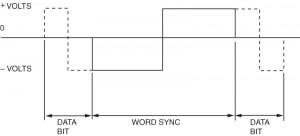
The data sync waveform shall be an invalid Manchester waveform as shown on figure 5. The width shall be three bit times, with the waveform being negative for the first one and one-half bit times, and then positive for the following one and one-half bit times: Note that if the bits preceding and following the sync are logic ones, then the apparent width of the sync waveform will be increased to four bit times.
4.3.3.5.2.2 Data
The sixteen bits following the sync shall be utilized for data transmission as specified in 4 3 2
4.3.3.5.2.3 Parity
The last bit shall be utilized for parity as specified in 4.3.3.5.1.6
4.3 Characteristics - Part 5
4.3.3.5.3. Status Word
A status word shall be comprised of a sync waveform, RT address, message error bit, instrumentation bit, service request bit, three reserved bits, broadcast command received bit, busy bit, subsystem flag bit, dynamic bus control bit, terminal flag bit, and a parity bit. For optional broadcast operation, transmission of the status word shall be suppressed as specified in 4 3 3 6 7.
4.3.3.5.3.1 Sync
The status sync waveform shall be as specified in 4.3.3.5.1.1.
4.3.3.5.3.2 RT Address
The next five bits following the sync shall contain the address of the RT which is transmitting the status word as defined in 4.3.3.5.1.2.

The status word is part of the basic overhead requirements of the data bus system. The status word is shown in figure II-4.5 is divided into the following fields:
- Sync (same as command sync)
- Terminal address
- Status field
- Parity (P)
The five-bit address field identifies the transmitting terminal’s address, while the remote terminal’s status is based on bits set in the status field. The status field consists of the following information:
- Message error bit
- Instrumentation bit
- Service request bit
- Reserved field
- Broadcast command received bit
- Busy bit
- Subsystem flag
- Dynamic bus control acceptance bit
- Terminal flag
4.3.3.5.3.3 Message Error Bit
The status word bit at bit time nine (see figure 3) shall be utilized to indicate that one or more of the data words associated with the preceding receive command word from the bus controller has failed to pass the RT’s validity tests as specified in 4.4.1.1 This bit shall also be set under the conditions specified in 4.4.1.2, 4.4.3.4 and 4.4.3.6. A logic one shall indicate the presence of a message error, and a logic zero shall show its absence All RT’s shall implement the message error bit.
The message error bit is set to logic one to indicate that one or more of the data words associated with the preceding received message failed to pass the message validity test. Message validity requirements are:
- Word validation — word begins with valid sync, Manchester II code correctly transmitted, 16 data bits plus parity, and word parity odd
- Contiguous words within a message
- Address validation — matches address unique terminal or broadcast address
- Illegal command — a terminal with the illegal command detection circuitry detects an illegal command
The status word will be transmitted if the message validity requirements are met (see para. 4.4.3.5 and 4.4.3.6). When a message error occurs in a broadcast message format, the message error bit will be set in the status word and the status response withheld as required by broadcast message format.
4.3.3.5.3.4 Instrumentation Bit
The status word bit time of 10 (see figure 3) shall be reserved for the instrumentation bit and shall always be a logic zero. This bit is intended to be used in conjunction with a logic one in bit time 10 of the command word to distinguish between a command word and a status word. The use of the instrumentation bit is optional.
The instrumentation bit in the status field is set to distinguish the status word from the command word. Since the sync field (three bits) is used to distinguish the command and status words from a data word, a mechanism to distinguish command and status is provided by the instrumentation bit. By setting this bit to logic zero for all conditions and setting the same bit position in the command word to a logic one, the command and status words are identifiable. If used, this approach reduces the possible subaddress in the command word to 15 and requires subaddress 31 (11111) to be used to identify mode commands (both 31 and 32 are allowed). If not used, the bit will remain set to logic zero in the status word for all conditions.
4.3.3.5.3.5 Service Request Bit
The status word bit at bit time eleven (see figure 3) shall be reserved for the service request bit. The use of this bit is optional. This bit, when used, shall indicate the need for the bus controller to take specific predefined actions relative to either the RT or associated subsystem. Multiple subsystems, interfaced to a single RT, which individually require a service request signal shall logically OR their individual signals into the single status word bit. In the event this logical OR is performed, then the designer must make provisions in a separate data word to identify the specific requesting subsystem. The service request bit is intended to be used only to trigger data transfer operations which take place on an exception rather than periodic basis. A logic one shall indicate the presence of a service request, and a logic zero its absence. If this function is not implemented, the bit shall be set to zero.
The service request bit is provided to indicate to the active bus controller that a remote terminal requests service. When this bit in the status word is set to logic one, the active bus controller may take a predetermined action or use mode command (transmit vector word) to identify the specific request. The message format for acquiring this is discussed under transmit vector word mode command (see figure II-4.3).
4.3.3.5.3.6 Reserved Status Bits
The status word bits at bit times 12 through 14 are reserved for future use and shall not be used. These bits shall be set to a logic zero.
The three bit-field (12-14) is reserved for future requirements and is set to logic zero. Any bit in this field not set to logic zero will be disregarded.
4.3.3.5.3.7 Broadcast Command Received Bit
The status word at bit time 15 shall be set to a logic one to indicate that the preceding valid command word was a broadcast command and a logic zero shall show it was not a broadcast command. If the broadcast command option is not used, this bit shall be set to a logic zero.
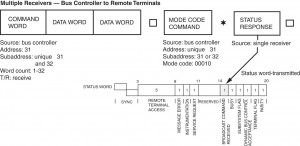
The broadcast command received bit is set to logic one when the preceding valid command word was a broadcast command (address 31). Since broadcast message formats require the receiving remote terminals to suppress their status words, the broadcast command received bit is set to identify that the command was received properly. If the broadcast message validity is desired, the message format shown in figure II-4.6 is used to determine this information. The broadcast command received bit will be reset when the next valid command is received by the remote terminal, unless the next valid command is transmit status word or transmit last command.
4.3 Characteristics - Part 6
4.3.3.5.3.8 Busy Bit
The status word bit at bit time 16 (see figure 3) shall be reserved for the busy bit. The use of this bit is optional. This bit, when used, shall indicate that the RT or subsystem is unable to move data to or from the subsystem in compliance with the bus controller’s command. A logic one shall indicate the presence of a busy condition, and a logic zero its absence. In the event the busy bit is set in response to a transmit command, then the RT shall transmit its status word only. If this function is not implemented, the bit shall be set to logic zero.
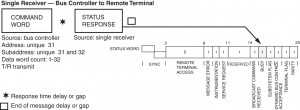
The busy bit in the status word is set to logic one to indicate to the active bus controller that the remote terminal is unable to move data to or from the subsystem in compliance with the bus controller’s command. The message format associated with a busy condition is shown in figure II-4.7. A busy condition can exist within a remote terminal at any time causing it to be nonresponsive to a command to send data or to be unable to receive data. This condition can exist for all message formats. In each case except the broadcast message formats, the active bus controller will determine the busy condition immediately upon status response. In the case of the broadcast message formats, this information will not be known unless the receiving terminals are polled after the broadcast message requesting their status. If the status word has the broadcast received bit set, the message was received and the terminal was not busy.
4.3.3.5.3.9 Subsystem Flag Bit
The status word bit at bit time 17 (see figure 3) shall be reserved for the subsystem flag bit. The use of this bit is optional. This bit, when used, shall flag a subsystem fault condition, and alert the bus controller to potentially invalid data. Multiple subsystems, interfaced to a single RT, which individually require a subsystem flag bit signal shall logically OR their individual signals into the single status word bit. In the event this logical OR is performed, then the designer must make provisions in a separate data word to identify the specific reporting subsystem. A logic one shall indicate the presence of the flag, and a logic zero its absence. If not used, this bit shall be set to logic zero.
The subsystem flag bit is provided to indicate to the active bus controller that a subsystem fault condition exists and that data being requested from the subsystem may be invalid. The subsystem flag may be set in any transmitted status word.
4.3.3.5.3.10 Dynamic Bus Control Acceptance Bit
The status word bit at bit time 18 (see figure 3) shall be reserved for the acceptance of dynamic bus control. This bit shall be used if the RT implements the optional dynamic bus control function. This bit, when used, shall indicate acceptance or rejection of a dynamic bus control offer as specified in 4.3.3.5.1.7.1. A logic one shall indicate acceptance of control, and a logic zero shall indicate rejection of control. If this function is not used, this bit shall be set to logic zero.
This bit is provided to indicate the acceptance of the bus controller offer by the active bus controller to become the next bus controller. The offer of bus control occurs when the presently active bus controller has completed its established message list and issues a dynamic bus control mode command to the remote terminal that is to be the next potential controller. To accept the offer the potential bus controller sets its dynamic bus control acceptance bit in the status word and transmits the status word. The establishment of who the next potential controller will be is a system issue.
4.3.3.5.3.11 Terminal Flag Bit
The status word bit at bit time 19 (see figure 3) shall be reserved for the terminal flag function. The use of this bit is optional. This bit, when used, shall flag a RT fault condition. A logic one shall indicate the presence of the flag, and a logic zero, its absence If not used, this bit shall be set to logic zero.
The terminal flag bit is set to a logic one to indicate a fault within the remote terminal. This bit is used in connection with three mode code commands:
- Inhibit T/F flag
- Override inhibit T/F flag
- Transmit BIT word
The first two mode code commands deactivate and activate the functional operation of the bit. The transmit BIT word mode code command is used to acquire more detailed information about the terminal’s failure.
4.3.3.5.3.12 Parity Bit
The least significant bit in the status word shall be utilized for parity as specified in 4 3.3 5.1.6.
The use of a single parity bit per word was provided to identify any bit errors occurring during the transmission and detection of a word. This odd parity check will detect an odd number of bit errors occurring in a word. This requirement produces an undetected bit error rate of 10-‘2, which was considered satisfactory for a general-purpose information transfer system. This paragraph remained unchanged during both revisions. See also 1553B, paragraph 4.3.3.5.1.6.
4.3.3.5.4. Status Word Reset
The status word bit with the exception of the address, shall be set to logic zero after a valid command word is received by the RT with the exception as specified in 4.3.3.5.1.7. If the conditions which caused bits in the status word to be set (e.g., terminal flag) continue after the bits are reset to logic zero, then the affected status word bit shall be again set, and then transmitted on the bus as required.
This paragraph was added to 1553B to clarify the hardware requirements associated with resetting the status code field of the status word. Figure II-4.5 shows the status word and the information available in this field.
One reason for the reset definition is to provide:
- The ability to obtain the latest status information of the remote terminal: this prevents conditions from being reported for longer than they actually exist.
- The ability to obtain the status code analysis of the previous results of a valid command: this allows an orderly error handling and recovery approach to be accomplished by the bus controller with the information associated with error analysis data contained within this field or other data associated within the RT (e.g., last command word and BIT).
The second reason for obtaining the status code field not reset was to allow error recovery using two mode codes of paragraph 4.3.3.5.1.7. Even though all mode codes are referenced in the status word reset paragraph, only two are required to retain the last status word in the terminal:
- Transmit status word
- Transmit last command word
In other words, all other valid messages received, including mode commands, will allow the RT to reset the status word, except these two.
Both of these mode codes can be transmitted to the RT without changing the bits in the status code field of the last valid command word in question. Therefore, it is essential that an error recovery procedure be established for the bus controller that takes into account (1) the ability of the RT hardware to collect error data, (2) the format of the data that must be requested by the bus controller to prevent data lost, and (3) the ability of the bus controller hardware and software to receive and react to these data. As many as three mode codes may be involved in this process:
- Transmit last command
- Transmit status word
- Transmit BIT word
4.3.3.6 Message Formats

The messages transmitted on the data bus shall be in accordance with the formats on figure 6 and figure 7. The maximum and minimum response times shall be as stated in 4.3.3.7 and 4.3.3.8. No message formats, other than those defined herein, shall be used on the bus.
The 1553B section of the standard contains two additional message format description that are not contained in revision A. One of these is an explanation of the optional mode code message format that is allowed in revision A but not described with message format diagrams. The other description is the message formats associated with the optional broadcast protocol.
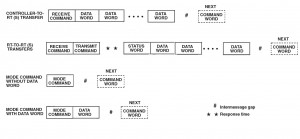
4.3 Characteristics - Part 7
a. Data massages
b. Control messages
4.3.3.6.1 Bus Controller to Remote Terminal Transfers
The bus controller shall issue a receive command followed by the specified number of data words. The RT shall, after message validation, transmit a status word back to the controller. The command and data words shall be transmitted in a contiguous fashion with no interword gaps.
4.3.3.6.2 Remote Terminal to Bus Controller Transfers
The bus controller shall issue a transmit command to the RT. The RT shall after command word validation, transmit a status word back to the bus controller, followed by the specified number of data words. The status and data words shall be transmitted in a contiguous fashion with no interword gaps.
4.3.3.6.3 Remote Terminal to Remote Terminal Transfers
The bus controller shall issue a receive command to RT A followed contiguously by a transmit command to RT B. RT B shall, after command verification, transmit a status word followed by the specified number of data words. The status and data words shall be transmitted in a contiguous fashion with no gap. At the conclusion of the data transmission by RT B, RT A shall transmit a status word within the specified time period.
4.3.3.6.4. Mode Command Without Data Word
The bus controller shall issue a transmit command to the RT using a mode code specified in table II-4.1. The RT shall, after command word validation transmit a status word.
4.3.3.6.5 Mode Command With Data Word (Transmit)
The bus controller shall issue a transmit command to the RT using a mode code specified in table II-4.1. The RT shall, after command word validation, transmit a status word followed by one data word. The status word and data word shall be transmitted in a contiguous fashion with no gap.
4.3.3.6.6 Mode Command With Data Word (Receive)
The bus controller shall issue a receive command to the RT using a mode code specified in table II-4.1, followed by one data word. The command word and data word shall be transmitted in a contiguous fashion with no gap. The RT shall, after command and data word validation, transmit a status word back to the controller.
4.3.3.6.7 Optional Broadcast Command
See 10.6 for additional information on the use of the broadcast command.
4.3.3.6.7.1 Bus Controller to Remote Terminal(s) Transfer (Broadcast)
The bus controller shall issue a receive command word with 11111 in the RT address field followed by the specified number of data words. The command word and data words shall be transmitted in a contiguous fashion with no gap. The RT(s) with the broadcast option shall after message validation, set the broadcast command received bit in the status word as specified in 4.3.3.5.3.7 and shall not transmit the status word.
4.3.3.6.7.2 Remote terminal to Remote Terminal(s) Transfers (Broadcast)
The bus controller shall issue a receive command word with 11111 in the RT address field followed by a transmit command to RT A using the RT’s address. RT A shall, after command word validation, transmit a status word followed by the specified number of data words. The status and data words shall be transmitted in a contiguous fashion with no gap. The RT(s) with the broadcast option, excluding RT A, shall after message validation, set the broadcast received bit in the status word as specified in 4.3.3.5.3.7 and shall not transmit the status word.
4.3.3.6.7.3 Mode Command Without Data Word (Broadcast)
The bus controller shall issue a transmit command word with 11111 in the RT address field, and a mode code specified in table II-4.1. The RT(s) with the broadcast option shall after command word validation, set the broadcast received bit in the status word as specified in 4.3.3.5.3.7 and shall not transmit the status word.
4.3.3.6.7.4 Mode Command With Data Word (Broadcast)
The bus controller shall issue a receive command word with 11111 in the RT address field and a mode code specified in table II-4.1, followed by one data word. The command word and data word shall be transmitted in a contiguous fashion with no gap. The RT(s) with the broadcast option shall, after message validation set the broadcast received bit in the status word as specified in 4.3.3.5.3.7 and shall not transmit the status word.
Data messages are used to communicate subsystem data to meet the purpose of the integration. As in the control messages, there are two message types: single receiver and multiple receiver messages. These are transmitted in the following manner:
Single receiver
- Bus controller to remote terminal
- Remote terminal to bus controller
- Remote terminal to remote terminal
Multiple receivers
- Bus controller to multiple remote terminals
- Remote terminal to multiple remote terminals
Each of these messages is transmitted using command and status words for control operation. The command word is used to:
- Identify the receiving terminal(s)
- Identify if data are to be received or transmitted by the receiving terminal(s)
- Identify the specific message identification (subaddress) within the remote terminal(s)
- Notify the terminal(s) of the number of data words to be received or transmitted
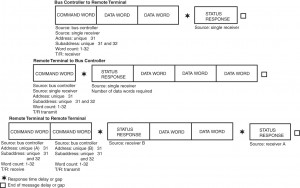
The command word, status word and data word format for accomplishing these messages are described in 4.3.3.5.1, 4.3.3.5.2, and 4.3.3.5.3.. Using these words, the format for data message transmissions is developed. The single receiver data message formats are shown in figure II-4.8. The message formats for multiple receiving terminals are shown in figure II-4.9.
Mode commands are used to manage the data bus system and are considered a necessary overhead requirement to properly control the data flow. The overhead requirements are provided by command words and status words. These header words to each data transmission are required to maintain system data flow within the multiplex system. Command and status words are associated with both control messages and data messages. Message formats within this protocol can be transmitted to a single receiver or to multiple receivers based upon the command word address for the message.
4.3 Characteristics - Part 8
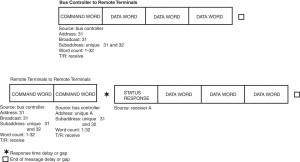
Mode commands are identified by the subaddress/mode field in the command word being set to 32 (00000) or 31 (11111). All control messages originate with the bus controller and are received by a single receiver or by multiple receivers (broadcast). A terminal address value of 31 (11111) in the command word indicates a broadcast message, and any other terminal address is used to identify unique mode commands to terminals on the bus. The mode command information is in the word count/mode code field of the command word and in the attached data word if allowed by the mode command.
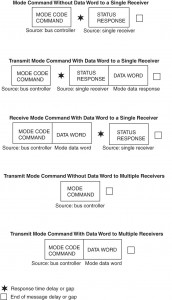
The various legal mode commands without and with data word are illustrated in figure II-4.10.
4.3.3.7 Intermessage Gap
The bus controller shall provide a minimum gap time of 4.0 microseconds (µs) between messages as shown on figure 6 and figure 7. This time period, shown as T on figure 8, is measured at point A of the bus controller as shown on figure 9 or figure 10. The time is measured from the mid-bit zero crossing of the last bit of the preceding message to midzero crossing of the next command word sync.
This paragraph in the 1553B expands the requirements of the response time (par. 4.3.1 in 1553A), by adding this intermessage gap paragraph. The purpose was to clearly identify that the bus controller shall not transmit contiguous messages (must have a gap) and that the maximum response time (12 µs par. 4.3.3.8) does not apply to gaps between messages. The bus controller may issue messages with a gap time greater than 4 µs.
4.3.3.8 Response Time
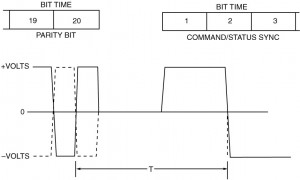
The RT shall respond, in accordance with 4.3.3.6, to a valid command word within the time period of 4.0 to 12.0 µs. This time period, shown as T on figure 8, is measured at point A of the RT as shown on figure 9 or figure 10. The time is measured from the mid-bit zero crossing of the last word as specified in 4.3.3.6 and as shown on figure 6 and figure 7 to the midzero crossing of the status word sync.
- This paragraph in 1553B relates to paragraph 4.3.1 in 1553A with the following changes:
The maximum response time was increased by 100% (5 to 10 µs or 7 to 12 µs when using the measurement techniques described below). -
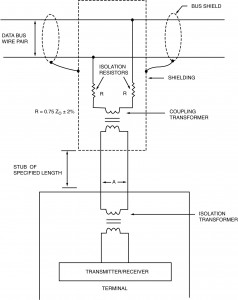
Figure 9 of MIL-STD-1553B: Data Bus Interface Using Transformer Coupling The point of measurement to establish the time was identified and was chosen to be a different point than was usually interpreted to be in 1553A. The 4 to 12 µs response time will allow more hardware design flexibility in the multiplex interface area. Also, the measurement technique was undefined in 1553A and because it is hard to determine when the multiplex line is quiet (dead), the measurement is easier to make if the previous mid-bit (zero) crossing and next mid-bit crossing are examined.
4.3.3.9 Minimum No-Response Time-Out
The minimum time that a terminal shall wait before considering that a response as specified in 4.3.3.8 has not occurred shall be 14.0 µs. The time is measured from the mid-bit zero crossing of the last bit of the last word to the mid-zero crossing of the expected status word sync at Point A of the terminal as shown on figure 9 or figure 10.
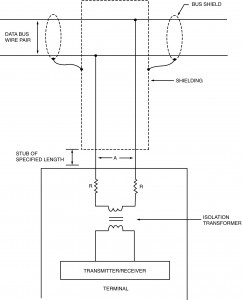
This new requirement of 1553B is provided to clarify the minimum time that a bus controller shall wait before concluding that the RT is not going to respond as requested. This is measured from the end of its transmission (last mid-bit crossing) to the expected response (first mid-bit crossing). Notice that this represents the minimum wait time on the same bus where the previous message was requested from the RT.
4.4 Terminal Operation - Part 1
4.4.1 Common Operation
Terminals shall have common operating capabilities as specified in the following paragraphs.
4.4.1.1 Word Validation
The terminal shall insure that each word conforms to the following minimum criteria:
- The word begins with a valid sync field.
- The bits are a valid Manchester II code.
- The word parity is odd.
When a word fails to conform to the preceding criteria, the word shall be considered invalid.
4.4.1.2 Transmission Continuity
The terminal shall verify that the message is contiguous as defined in 4.3.3.6. Improperly timed data syncs shall be considered a message error.
4.4.1.3 Terminal Fail-Safe
The terminal shall contain a hardware implemented timeout to preclude a signal transmission of greater than 800.0 µs. This hardware shall not preclude a correct transmission in response to a command. Reset of this timeout function shall be performed by the reception of a valid command on the bus on which the timeout has occurred.
This paragraph describes the common operation associated with terminals connected to the data bus system. Performance requirements include: word validation, transmission continuity, and terminal fail-safe.
The word validation paragraph has been modified to explain more fully the detection and response required. These requirements are contained in 1553B paragraphs (word validation, 4.4.1.1), (transmission continuity, 4.4.1.2), and (invalid data reception, 4.4.3.6). The new and modified paragraphs should provide sufficient information concerning invalid words or invalid messages.
The terminal fail-safe requirement prevents excessive transmissions on a data bus by a single transmitter, which would preclude its effective use. Changes in 1553B to 800 µs (par 4.4.1.3) instead of 660 µs (par. 4.3.2) will allow less accurate analog or relaxed digital timers with more independence of the timer circuits to be used in the current design. In addition there were several mechanisms to reset this fail-safe timer described in 1553B. These include the following:
- Reset of this timeout function shall be performed by the reception of a valid command on the bus on which the timeout has occurred (par. 4.4.1.3).
- The mode command override transmitter shutdown (00101 for two-bus system or 10101 for multiple-bus system) on an alternative bus can also be used to reset the timer.
- The mode command reset remote terminal (01000) causes the remote terminal to assume a power-up initialized state that can also be used to reset the timer.
Both 2 and 3 are optional ways to reset the timer and may depend on the system and hardware implementations. However, the preferred reset approach is to transmit the appropriate mode code.
4.4.2 Bus Controller Operation
A terminal operating as a bus controller shall be responsible for sending data bus commands, participating in data transfers, receiving status responses, and monitoring system status as defined in this standard. The bus controller function may be embodied as either a stand-alone terminal, whose sole function is to control the data bus(s), or contained within a subsystem. Only one terminal shall be in active control of a data bus at any one time.
This paragraph is generally the same paragraph in both 1553A (4.5) and 1553B.
4.4.3 Remote Terminal
4.4.3.1 Operation
A remote terminal (RT) shall operated in response to valid commands received from the bus controller. The RT shall accept a command word as valid when the command word meets the criteria of 4.4.1.1, and the command word contains a terminal address which matches the RT address or an address of 11111, if the RT has the broadcast option.
The remote terminal operation has been expanded in 1553B to include the broadcast option and additional definitions associated with: superseding valid commands (par. 4.4.3.2), invalid commands (par. 4.4.3.3), illegal commands (par. 4.4.3.4), valid data reception (par 4i4.3.6), and invalid data reception (par. 4.4.3.6).
4.4 Terminal Operation - Part 2
4.4.3.2 Superseding Valid Commands
The RT shall be capable of receiving a command word on the data bus after the minimum intermessage gap time as specified in 4.3.3.7 has been exceeded, when the RT is not in the time period T as specified in 4.3.3.8 prior to the transmission of a status word, and when it is not transmitting on that data bus. A second valid command word sent to an RT shall take precedence over the previous command. The RT shall respond to the second valid command as specified in 4.3.3.8.
The superseding valid command requirement clarifies the gap time issue in 1553A (par.4.3). “A second valid command word sent to a terminal after it is already operating on one shall invalidate the first command and cause the RT to begin operation on the second command. ” This phrase in 1553A can be misinterpreted to indicate that near back-to-back (no gap or only 4 µs gap) commands can be sent to a terminal on the same bus and the terminal will respond to the second command.
However, this was not the intention because in certain cases an RT responding with a status word slightly greater than 4 µs would collide with the second command being transmitted by the bus controller. The intended purpose for this requirement is to allow the bus controller to reissue an identical transmission or issue a new transmission on the same bus to the same RT, when an RT fails to respond to a command on that bus. This method is described in the 1553B by requiring a minimum time T (greater than a gap time but less than a full 32-word message) to occur prior to transmitting the second command. Therefore, the bus controller is assured that the RT is not responding and a new command on the same bus is appropriate. Figure 8 in 1553B demonstrates this intermessage gap problem and solution.
4.4.3.3 Invalid Commands
A remote terminal shall not respond to a command word which fails to meet the criteria specified in 4.4.3.1.
Command words that fail to meet the word validation requirement cause the system to continue to “look” for a valid command word. When this condition occurs, no change occurs to the status word and no response is transmitted by the RT. This operation is identified as invalid command. This paragraph is used to cover failure in the decoding process of the command word. To prevent multiple responses by two or more terminals to a command word (one without a failure and one with) the terminal that cannot absolutely validate a command word must take the safe approach and reset the circuitry and continue to look for a valid command word that meets it particular requirements (address). All RT’s should use this approach of not responding, when there is a question about the commands. This approach is considered to be a fail-passive approach providing the least impact on the multiplex system.
4.4.3.4 Illegal Command
An illegal command is a valid command as specified in 4.4.3.1, where the bits in the subaddress/mode field, data word count/mode code field, and the T/R bit indicate a mode command, subaddress, or word count that has not been implemented in the RT. It is the responsibility of the bus controller to assure that no illegal commands are sent out. The RT designer has the option of monitoring for illegal commands. If an RT that is designed with this option detects an illegal command and the proper number of contiguous valid data words as specified by the illegal command word, it shall respond with a status word only, setting the message error bit, and not use the information received.
Illegal commands are command words that have passed the word validation test but do not comply with the system’s capability. These include command words where the subaddress-mode field, data word/mode code field, or the T/R bit are set so that they represent conditions not allowed in the system. These include both conditions not allowed by the standard and any additional condition not allowed in a particular system design. The responsibility for not allowing illegal commands to be transmitted is given to the bus controllers. Since the bus controller is responsible for all command/ response message communications, it will be a design goal that the bus controller not transmit an invalid command.
Two methods can be provided to meet this requirement: (1) careful generation of bus controller commands in the development of the system and tight control of the change process during operational use and (2) examination of failure modes of the controller hardware and software to determine potentially illegal command generations and transmissions. An additional method of rejecting illegal commands in the multiplex system can only be provided by circuitry within the receiving remote terminal. This approach is an optional capability for remote terminals built to the 1553B standard. If an RT with this capability detects an illegal command that meets all other validation requirements, the RT shall respond with a status word with only the message error bit set and not use the information sent or disregard the request for information.
4.4.3.5 Valid Data Reception
The remote terminal shall respond with a status word when a valid command word and the proper number of contiguous valid data words are received, or a single valid word associated with a mode code is received. Each data word shall meet the criteria specified in 4.4.1.1.
The purpose of the valid data reception in 1553B was to clearly state when a message containing at least one data word would be responded to by the appropriate RT. Previous systems have taken different approaches to messages with various failures (e.g., under word count, over word count, parity errors in words, gaps in word transmissions). Therefore, this requirement was established to identify the only time status words would be transmitted by the RT after the reception of a data message with at least one data word. It should be noted that one other message format will produce a status word response: mode code without data word transmitted to a specific RT (not broadcast).
4.4.3.6 Invalid Data Reception
Any data word(s) associated with a valid receive command that does not meet the criteria specified in 4.4.1.1 and 4.4.1.2 or an error in the data word count shall cause the remote terminal to set the message error bit in the status word to a logic one and suppress the transmission of the status word. If a message error has occurred, then the entire message shall be considered invalid.
In contrast to the valid data reception status response, certain action is required when an invalid data reception occurs. This paragraph in 1553B is an expanded version of the two 1553A paragraphs 4.2.5.4.4 and 4.2.3.5.3.3. This again assumes message formats with associated data word(s), thus mode code commands without a data word are rightly excluded from this group however, in contrast to valid data reception where broadcast message protocol were excluded, here they are included. Therefore, all message formats containing a least one data word (e.g., broadcast data messages, nonbroadcast data messages, broadcast mode codes with a data word, and mode codes with a data word) are included in this requirement. As stated in the requirement, the message command word has been validated and the error occurs in the data word portion of the message. The withholding or suppression of the status response alerts the bus controller error detection electronics to the fact that an incomplete message has occurred and some level of error recovery must occur. The setting of the message error bit in the status that remains in the RT will provide additional information to the error recovery circuitry only if the bus controllers request the status word using the appropriate mode code.
Also notice that the requirement is that the entire received message be considered invalid. This message invalidation requirement may cause some systems like electrical multiplex (EMUX) a problem. Since the EMUX system usually have bit-oriented data rather than word or multiple words (message) oriented data, errors in a word following the reception of good data will invalidate good data. It has been proposed that such a system invalidate all data words from the failure to the end of the message and use previously good data words. This approach, however, has not been allowed. Regardless of the approach, some system mechanisms will store the data and then tag the message as being invalid; others will not allow the user to receive the data. In the first case, it is the responsibility of the user to examine the message valid indication prior to using the data; however, in the second case, the user must recognize that the data has not been updated.
4.4.4 Bus Monitor Operation
A terminal operating as a bus monitor shall receive bus traffic and extract selected information. While operating as a bus monitor, the terminal shall not respond to any message except one containing its own unique address if one is assigned. All information obtained while acting as a bus monitor shall be strictly used for off-line applications (e.g., flight test recording, maintenance recording or mission analysis) or to provide the back-up bus controller sufficient information to take over as the bus controller.
A terminal may operate in the bus monitor mode for two reasons: (1) information recording for off-line analysis and (2) information source for backup bus controller. The unique feature of this mode is that it has the ability to decode and accept for data storage any or all messages transmitted on the data bus without the knowledge of or without affecting the operation of multiplex system or the terminal(s) attached to the bus. It also has the option of not being addressable as a terminal attached to the bus. If this is the case, it acts in the “listen capability only” to the system. In this implementation, data cannot be sent to it specifically, but the monitor may collect data by recording message traffic. However, the same terminal may operate in the remote terminal and potential bus controller (backup bus controller) mode as well as having the additional capability to monitor and store all message traffic or an internally derived subset of all messages. It is because of this second capability, its nonpassive nature, that a terminal with the monitor mode is an extremely powerful device in the multiplex system.
4.5 Hardware Characteristics - Part 1
The hardware characteristic section of 1553B examines data bus characteristics (par. 4.5.1) and terminal characteristics (par. 4.5.2). This section is similar to the terminal operation paragraphs (4.3) and the transmission line (4.2.4) of 1553A. Paragraph 4.4 in 1553A (Terminal to Subsystem Interface) has been deleted from 1553B completely. This deletion was consistent with the emphasis on a data bus protocol standard and an electrical multiplex interface requirement treating the terminals interfacing to the multiplex bus as black box interfaces and not defining any internal interfaces.
4.5.1 Data Bus Characteristics
4.5.1.1 Cable
The cable used for the main bus and all stubs shall be a two conductor, twisted shielded, jacketed cable. The wire-to-wire distributed capacitance shall not exceed 30.0 picofarads per foot. The cables shall be formed with not less than four twists per foot where a twist is defined as a 360 degree rotation of the wire pairs; and, the cable shield shall provide a minimum of 75.0 percent coverage.
4.5.1.2 Characteristic Impedance
The nominal characteristic impedance of the cable (ZO) shall be within the range of 70.0 Ohms to 85.0 Ohms at a sinusoidal frequency of 1.0 megahertz (MHz).
4.5.1.3 Cable Attenuation
At the frequency of 4.5.1.2, the cable power loss shall not exceed 1.5 decibels (dB)/100 feet (ft).
Table II-4.4 contains a summary listing of the data bus and coupling requirements contained in 1553A and 1553B. The characteristics of the twisted shielded pair cable have been relaxed to allow selection of cable types from a variety of manufacturers. It has been shown than minor variations from the specified cable characteristics do not significantly affect the system performance.
A great deal of concern and confusion has resulted because of the cable network requirements, including bus length, coupling, and stubbing. 1553 and 1553A did not provide adequate guidelines for bus network design, especially for the transformer coupled stub. 1553A defined a maximum cable length of 300 ft for the main bus while 1553B chose not to specify a maximum main bus length since it is reasoned that the cable length, number of terminals, and length of stubs are all subject to tradeoff and must be considered in the design for reliable system operation. In other words, an arbitrary limit of 300 ft should not be applied since all parameters of the network must be considered.
4.5.1.4 Cable Termination
The two ends of the cable shall be terminated with a resistance, equal to the selected cable nominal characteristic impedance (Zo) ± 2.0 percent.
4.5.1.5 Cable Stub Requirements
The cable shall be coupled to the terminal as shown on figure 9 or figure 10. The use of long stubs is discouraged, and the length of a stub should be minimized. However, if installation requirements dictate, stub lengths exceeding those lengths specified in 4.5.1.5.1 and 4.5.1.5.2 are permissible.
4.5.1.5.1 Transformer Coupled Stubs
The length of a transformer coupled stub should not exceed 20 fees. If a transformer coupled stub is used, then the following shall apply.
4.5.1.5.1.1 Coupling Transformer
A coupling transformer, as shown on figure 9, shall be required. This transformer shall have a turns ratio of 1:1.41 ± 3.0 percent, with the higher turns on the isolation resistor side of the stub.
A generalized multiplex bus network configuration is shown in figure 1. The main bus is terminated at each end in the cable characteristic impedance to minimize reflections caused by transmission line mismatch. With no stubs attached, the main bus looks like an infinite length transmission line and therefore there are no disturbing reflections. When the stubs are added for connection of the terminals, the bus is loaded locally and a mismatch occurs with resulting reflections. The degree of mismatch and signal distortions caused by reflections are a function of the impedance (Z) presented by the stub and terminal input impedance. In order to minimize signal distortion, it is desirable that the stub maintain a high impedance. This impedance is reflected back to the main bus. At the same time the impedance needs to be kept low so that adequate signal power will be delivered to the receiver input. Therefore, a tradeoff and compromise between these conflicting requirements is necessary to achieve the specified signal-to-noise ratio and system error rate performance. Two methods for coupling a terminal to the main bus are defined in 1553B, transformer coupling and direct coupling. The two methods are shown in figures 9 and 10 of 1553B. Transformer coupling is usually used with long stubs (1 to 20 ft) and requires a coupler box, separate from the terminal, located near the junction of the main bus and stub. Direct coupling is usually limited for use with stubs of less than 1 ft.
Fault isolation resistors (R) are included to provide protection for the main bus in case of a short circuit in the stub or terminal. The coupler-transformer characteristics defined in 1553B and listed in table 7-4 provide a compromise between the signal level and distortion characteristics delivered to the terminals. The coupler transformer turns ratio (1:1.41) provides impedance transformation for both l/ reception and transmission. The improvement of stub load impedance is a result of impedance transformation, which is proportional to the square of the turns ratio, assuming an ideal coupler transformer.
As indicated above, the 1:1.41 transformer also provides ideal termination of the stub for transmission of signals from the terminal to the main bus. The impedance at main bus is
where
The reflected impedance, ZR, from the bus to the stub due to the transformer impedance transformation is
Therefore, the coupler transformer specified in 1553B provides the characteristics desired for reducing reflections and maintaining signal levels for systems where long stubs are required.
4.5.1.5.1.1.1 Transformer Input Impedance
The open circuit impedance as seen at point B on figure 11 shall be greater than 3000 ohms over the frequency range of 75.0 kilohertz (kHz) to 1.0 megahertz (MHz), when measured with a 1.0V root-mean-square (RMS) sine wave.
The transformer open circuit impedance (Zoc) is required to be greater than 3k ohms in 1553B systems. The measurement is made looking into the higher turns winding (1.41) with a 75 kHz to 1 MHz sine wave signal. The test amplitude at the transformer winding is adjusted to 1 V rms. The critical factors in achieving the 3k ohm Zoc is the distributed capacitance of the windings and the transformer primary inductance. The inductance of the transformer must be large enough to provide the open circuit impedance at 75 kHz and the distributed capacitance should be small enough to maintain the open circuit impedance at the 1 MHz test frequency. The inductance may obviously be increased by increasing the number of turns on the transformer. This technique, however, tends to increase the distributed capacitance, degrading high frequency performance and therefore causing waveform integrity and common mode rejection to suffer.
4.5 Hardware Characteristics - Part 2
4.5.1.5.1.1.2 Transformer Waveform Integrity
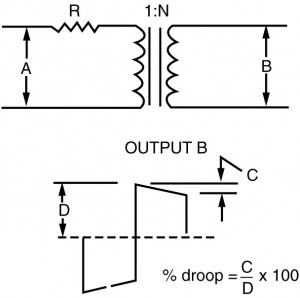
The droop of the transformer using the test configuration shown on figure 11 at point B, shall not exceed 20.0 percent. Overshoot and ringing as measured at point B shall be less than ±1.0V peak. For this test, R shall equal 360.0 ohms + 5.0 percent and the input A of figure 11 shall be a 250.0 kHz square wave, 27.W peak-to-peak, with a rise and fall time no greater than 100 nanoseconds (ns).
The ability of the coupler transformer to provide a satisfactory signal is specified in the droop, overshoot, and ringing requirements of 1553B shown in figure II-4.11. Droop is specified at 20% maximum when driving the transformer with a 250 kHz, 27V pep square wave.
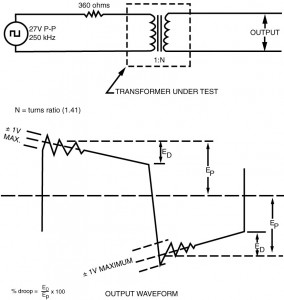
The test for the droop characteristic is made by driving the low turns winding through a 360 ohm resistor and measuring the signal at the open-circuited high side winding. The droop of the transformer is determined mainly by the primary inductance. Since the primary inductance a/so provides the 3k ohm open circuit impedance, the inductance should be made as high as possible without degrading the high-frequency performance of the transformer. Ringing and overshoot on the transformer signal is also shown in figure 11 and figure II-4.11. The ~ 1 V limit on these high-frequency perturbations can be achieved through careful attention to leakage inductance and transformer capacitance.
4.5.1.5.1.1.3 Transformer Common Mode Rejection
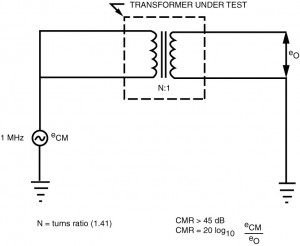
The coupling transformer shall have a common mode rejection ratio greater than 45.0 dB at 1.0 MHz.
The command mode rejection of the isolation transformer is required to be greater than 45.0 dB. The common mode test shown in figure II-4.12 consists of driving the high turns winding while measuring the differential signal across the high side. Common mode rejection can be improved by minimizing the interwinding capacitance and the core-to-winding capacitance.
4.5.1.5.1.2 Fault Isolation
An isolation resistor shall be placed in series with each connection to the data bus cable. This resistor shall have a value of 0.75 Zo plus or minus 2.0 percent, where Zo is the selected cable nominal characteristic impedance. The impedance placed across the data bus cable shall be no less than 1.5 Zo failure of the coupling transformer, cable stub, or terminal transmitter/receiver.
4.5.1.5.1.3 Cable Coupling
All coupling transformers and isolation resistors, as specified in 4.5.1.5.1.1 and 4.5.1.4.1.2, shall have continuous shielding which will provide a minimum of 75 percent coverage. The isolation resistors and coupling transformers shall be placed at minimum possible distance from the junction of the stub to the main bus.
4.5.1.5.1.4 Stub Voltage Requirements
Every data bus shall be designed such that all stubs at point A of figure 9 shall have a peak-to-peak amplitude, line-to-line within the range of 1.0 and 14.0 V for a transmission by any terminal on the data bus. This shall include the maximum reduction of data bus signal amplitude in the event that one of the terminals has a fault which causes it to reflect a fault impedance specified in 4.5.1.5.1.2 on the data bus. This shall also include the worst case output voltage of the terminals as specified in 4.5.2.1.1.1 and 4.5.2.2.1.1.
4.5.1.5.2 Direct Coupled Stubs
The length of a direct coupled stub should not exceed 1 foot. Refer to 10.5 for comments concerning direct coupled stubs. If a direct coupled stub is used, then the following shall apply.
4.5.1.5.2.1 Fault Isolation
An isolation resistor shall be placed in series with each connection to the data bus cable. This resistor shall have a value of 55.0 ohms plus or minus 2.0 percent. The isolation resistors shall be placed within the RT as shown on figure 10.
4.5.1.5.2.2 Cable Coupling
All bus-stub junctions shall have continuous shielding which will provide a minimum of 75 percent coverage.
4.5.1.5.2.3 Stub Voltage Requirements
Every data bus shall be designed such that all stubs at point A of figure 10 shall have a peak-to-peak amplitude, line-to-line within the range of 1.4 and 20.0 V for a transmission by any terminal on the data bus. This shall include the maximum reduction of data bus signal amplitude in the event that one of the terminals has a fault which causes it to reflect a fault impedance of 110 Ohms on the data bus. This shall also include the worst case output voltage of the terminals as specified in 4.5.2.1.1.1 and 4.5.2.2.1.1.
4.5.1.5.3 Wiring and Cabling for EMC
For purposes of electromagnetic capability (EMC), the wiring and cabling provisions of MIL-E-6051 shall apply.
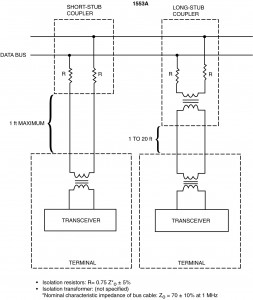
The requirements for couplers specified in 1553A have been modified for 1553B and a comparison of the two requirements is shown in figure II-4.13A and figure II-4.13B. The major difference in the two requirements is the placement of the isolation resistors for the direct-coupled (short-stub) connection and the characterization of the coupling transformer in the long-stub (transformer-coupled) connection. With the isolation resistors located in the terminal for the direct-coupled case, the need for a separate coupler box is eliminated as long as a reliable shielded splice can be maintained.
The terminal input and output specifications for the transformer-coupled and direct-coupled connections are required to be separated in 1553B because of the effects on signal levels and impedances of the transformer turns ratio being specified as 1:1.41 instead of the assumed 1:1 in 1553A.
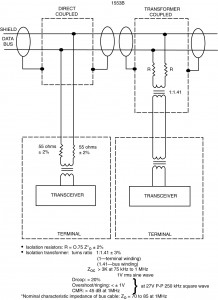
The transformer in the 1553B coupler has the turns ratio of 1:1.41. This ratio, together with the 0.75Z fault isolation resistor provides the correct characteristic impedance for terminating the stub:
The stub capacitance is also effectively decreased by the square of the turns ratio to lessen the loading problem. The 1:1.41 ratio of 1553B is a compromise between stub matching and decreased stub loading.
The connector type specified is important for severe environment military aircraft applications. MIL-STD-1553A specified the use of two-pin polarized connectors such as TEI BJ37 (reference to “TEL-14949-E137” is in error). The two-pin polarized connector employs an interface configuration with one male and one female contact. The female contact is embedded in one side of a step dielectric and the male contact is exposed. There are several shortcomings inherent in this design. MIL-STD1553B does not specify connector types.
The coupling network provides bus connections for the transformer-coupled (external coupler) and direct-coupled cases defined in 1553B. Isolation resistors of 55 ohms value are included for the direct-coupled connection, and the proper transformer turns ratio is provided when the appropriate bus connection is selected. The turns ratio is different for the transformer-coupled and direct-coupled connections to compensate for the 1.41 to 1 reduction of signal level in the external coupler. This feature allows a threshold setting that is the same for both bus connections.
4.5.2 Terminal Characteristics
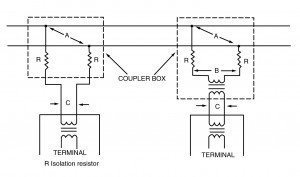
An additional concern is the specification for the bus and terminal interface. This area of 1553A was significantly reworked to provide a more complete definition of the terminal interface characteristics that are independent of network configuration. Figures II-4.14 and II-4.15 show the interface diagrams and the points where the signal measurement are defined in 1553A and 1553B. Table II-4.5 is a summary listing of the terminal and data bus interface requirements specified in the two versions of the standard.
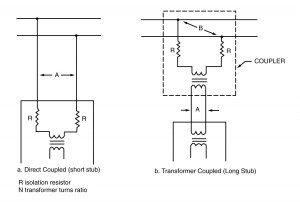
The following discussion will relate some of the rationale for this approach to development of the updated requirements in 1553B.
4.5.2.1 Terminals With Transformer Coupled Stubs
4.5.2.1.1 Terminal Output Characteristics
The following characteristics shall be measured with RL, as shown on figure 12, equal to 70.0 Ohms ± 2.0 percent.
4.5.2.1.1.1 Output Levels
The terminal output voltage levels shall be measured using the test configuration shown on figure 12. The terminal output voltage shall be within the range of 18.0 to 27.0 V, peak-to-peak, line-to-line, when measured at point A on figure 12.

The upper end of the bus voltage range (20V p-p) allowed by 1553A was considered to be excessive and if implemented would result in excessive power dissipation and most of the systems and hardware designed to 1553A use signal levels at or near the lower end (6.0V p-p) of the specified range. It should be noted that the measurement point in 1553A is at the main bus, point A on figure 7 through figure 14. This does not provide a specified level at the terminal connection point (c) and is especially troublesome to the terminal hardware designer since the characteristics of the coupler transformer are not specified. The approach taken for 1553B is to specify the terminal output for the two conditions, transformer-coupled and direct-coupled. This may require that each terminal have two sets of input-output pins for each bus cable connection. Therefore the 18V to 27V p-p transmitter output applied to the stub and coupler results in a nominal 6.0V to 9.0V p-p signal level at the stub and bus connection (point B). This range is equivalent to that specified for the direct-coupled case shown in figure II-4.15. Test configurations are provided for both direct coupled and transformer-coupled in figure II-4.16.
4.5 Hardware Characteristics - Part 3
4.5.2.1.1.2 Output Waveform
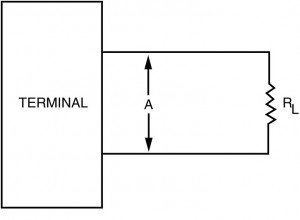
The waveform, when measured at point A on figure 12 shall have zero crossing deviations which are equal to, or less than, 25.0 ns from the ideal crossing point, measured with respect to the previous zero crossing (i.e., .5 ± .025 µs, 1.0 ± .025 µs, 1.5 ± .025 µs, and 2.0 ± .025 µs). The rise and fall time of this waveform shall be from 100.0 to 300.0 ns when measured from levels of 10 to 90 percent of full waveform peak-to-peak, line-to-line, voltage as shown on figure 13. Any distortion of the waveform including overshoot and ringing shall not exceed ± 900.0 millivolts (mV) peak, line-to-line, as measured at point A, figure 12.
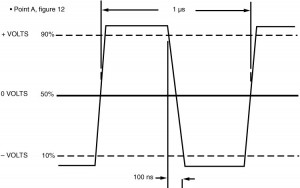
The transmitted waveform specified in 1553A is limited in the definition of signals that appear on the data bus. The zero crossing deviations allowed are not well defined for all possible patterns, and the rise and fall times specification is open ended. The waveform characteristics defined in 1553B provide control of the zero crossing deviations for all possible conditions and establishes a limit on distortion.
4.5.2.1.1.3 Output Noise
Any noise transmitted when the terminal is receiving or has power removed, shall not exceed a value of 14.0 mV, RMS, line-to-line, as measured at point A, figure 12.
MIL-STD-1553A specified value of 10 mV pep noise (4.25.3.3) is considered unrealistically low for practical hardware design. Also, noise is normally specified as an rms value since peak noise is difficult to measure. The output rms noise for the transformer-coupled and direct coupled cases are specified in 1553B (4.5.2.1.1.3 and 4.5.2.2.1.3) and are consistent with the required system performance and practical terminal hardware design. The requirement for low output noise of 14 mV rms and 5 mV rms when not transmitting also places significant constraints on the length and routing of input-output wiring because of the induced power supply and logic noise generated in the terminal.
4.5.2.1.1.4 Output Symmetry
From the time beginning 2.5 µs after the mid-bit crossing of the parity bit of the last word transmitted by a terminal, the maximum voltage at point A of figure 12 shall be no greater than ± 250.0 mV peak, line-to-line. This shall be tested with the terminal transmitting the maximum number of words it is designed to transmit, up to 33. This test shall be run six times with each word in a contiguous block of words having the same bit pattern. The six word contents that shall be used are 800016 7FFF16, 000016, FFFF16, 555516 , and AAAA16.
The output of the terminal shall be as specified in 4.5.2.1.1.1 and 4.5.2.1.1.2.
Symmetry of the transmitted waveform in time and amplitude was not adequately specified in 1553A. An ideal waveform is perfectly balanced so that the signal energy on both sides of zero (off) level is identical. If the positive or negative energy is not equal, problems can develop in the coupling transformers and the transmission line can acquire a charge that appears as a tail with overshoot and ringing when transmission is terminated. These considerations require that the symmetry of the transmitted waveform be controlled within practical limits. This is accomplished in 1553B by specifying the signal level from a time beginning 2.5 µs after the midbit zero crossing of the parity bit of the last word in a message transmitted by the terminal under test The test messages contain the maximum number of words and defined bit patterns.
4.5.2.1.2 Terminal Input Characteristics
The following characteristics shall be measured independently.
4.5.2.1.2.1 Input Waveform Compatibility
The terminal shall be capable of receiving and operating with the incoming signals specified herein, and shall accept waveform varying from a square wave to a sine wave with respect to the previous zero crossing of ±150 ns, (i.e., 2.0 ± .15 µs, 1.5 ± .15 µs, 1.0 ± .15 µs, .5 ± .15 µs). The terminal shall respond to an input signal whose peak-to-peak amplitude, line-to-line, is within the range of .86 to 14.0 V. The terminal shall not respond to an input signal whose peak-to-peak amplitude, line-to-line, is within the range of 0.0 to .20V. The voltages are measured at point A on figure 9.
4.5.2.1.2.2 Common Mode Rejections
Any signals from direct current (DC) to 2.0 MHz, with amplitudes equal to or less than ± 10.0 V peak, line-to-ground, measured at point A on figure 9, shall not degrade the performance of the receiver.
The input voltage specifications in 1553B have been revised to reflect the output voltage ranges for the transformer-coupled and direct-coupled connections to the terminal. The terminal required response and no-response signal levels are specified so that the optimum threshold levels may be selected. It should be noted that the threshold setting has a significant effect on the noise rejection and error rate performance of the receiver. The maximum value for no-response signal level is 200 mV p-p, and 280 mV p-p allows optimum threshold settings of ± 125 and ± 175 mV, respectively, for minimum bit error rate (BER) performance when subjected to the specified noise rejection test conditions.
4.5.2.1.2.3 Input Impedance
The magnitude of the terminal input impedance, when the RT is not transmitting, or has power removed, shall be a minimum of 1000.0 Ohms within the frequency range of 75.0 kHz to 1.0 MHz. This impedance is that measured line-to-line at point A on figure 9.
As indicated in the data bus network requirement, input impedance is required to be maintained at a reasonable level to reduce the signal distortion effects when terminals are connected to the bus. Terminal input impedance is determined primarily by the following:
- Transformer impedance maintains inductance required to support low-frequency component of signal while controlling interwinding capacitance for high frequencies.
- Terminal wiring capacitance controls stray capacitance of wiring from terminal connector to receiver.
- Secondary impedance transformation, for the transformer-coupled case, a transformer with a turns ratio of 1:1.41 is implied. The impedance at the secondary is reflected to the terminal input reduced by a factor of 2
The transformer is a very important element in determining the transceiver characteristics such as input impedance, signal waveform integrity, and common mode rejection required by 1553B. The considerations for transformer and associated input-output circuit design are to:
- Provide the specified input impedance at high frequencies (terminal input impedance 1,000 ohms and 2,000 ohms at 1 MHz)
- Design for low interwinding capacitance to achieve the common mode rejection (45 dB CMR at ± 10V peak, dc to 2.0 MHz)
These considerations are directly applicable to the design of the transceiver transformer. In addition to the transformer characteristics other considerations for maintaining the terminal minimum input impedance specified in 1553B are as follows:
- Minimize stray capacitance of wiring from the external connector and on the circuit card to the buffer amplifier (every 100 pF results in approximately 1,600 ohms of shunt impedance).
- Maintain high impedance at the receiver limiter and filter circuit inputs and transmitter driver outputs in the “off” state. These impedances must be maintained with the terminal (transceiver) power off.
The factor of 2 difference in the impedance specified for the transformer-coupled and direct-coupled cases is based primarily on the effect of c. The frequency range was changed to reduce the lower frequency limit from 100 kHz (1553A) to 75 kHz (1553B). This provides additional assurance that adequate transformer volt-time product (inductance) is available to support the lower frequencies of the signal without approaching saturation.
4.5 Hardware Characteristics - Part 4
4.5.2.1.2.4 Noise Rejection
The terminal shall exhibit a maximum word error rate of one part in 107, on all words received by the terminal, after validation checks as specified in 4.4, when operating in the presence of additive white Gaussian noise distributed over a bandwidth of 1.0 kHz to 4.0 MHz at an RMS amplitude of 140 mv. A word error shall include any fault which causes the message error bit to be set in the terminal’s status word, or one which causes a terminal to not respond to a valid command. The word error rate shall be measured with a 2.1 V peak-to-peak, line-to-line, input to the terminal as measured at point A on figure 9. The noise tests shall be run continuously until, for a particular number of failures, the number of words received by the terminal, including both command and data words, exceeds the required number for acceptance of the terminal or is less than the required number for rejection of the terminal as specified in table II-4.6. All data words used in the tests shall contain random bit patterns. These bit patterns shall be unique to each data word in a message and shall change randomly from message to message.
The noise rejection specification and test conditions defined in 1553A requires extensive system-type evaluation testing of the terminal employing a bus controller and data bus radiated with certain of the EMI fields specified in MIL-STD-461 and 462 Extensive test time is required to verify a BER of 10-12 and the test must be performed in a screen room.
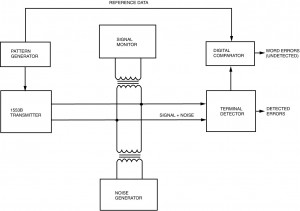
The test conditions of signal and noise specified in 1553B were selected to produce a corresponding value of word error rate (WER) which is sufficiently high (10 -7) to permit performance verification of a terminal receiver within a reasonable test period. The noise rejection is a figure-of-merit test and can be performed in a normal laboratory environment using actual transmitters (Manchester waveform output) with a typical test setup as shown in figure II-4.17. The verification of detector performance should consider the measurement of both detected and undetected errors. To measure undetected errors that do not correlate with the transmitted signal and are not detected by the terminal under test, it is necessary to compare the transmitted and received data. Therefore, a reference of transmitted data is provided to the comparator for comparison with the deleted data from the terminal under test.
Externally generated noise on board an aircraft can take many forms with a wide variety of power and frequencies. It is recognized that impulse noise having either random or periodic impulse duration, frequency of occurrences, and burst interval are more typical of noise sources that have major impact on aircraft digital data systems. Relay switching is generally regarded as the most severe source of impulse noise on a typical aircraft. This type of noise defies accepted forms of analysis, such as that performed utilizing additive white Gaussian (AWG) noise model. Because of the difficulty of error performance analysis using the impulsive noise model, a worst-case Gaussian model has been formulated. This model offers an analysis and test tool for evaluation of terminal receiver performance considering the effects of impulsive noise. This approach is reflected in the noise rejection test conditions and word error rate versus signal-to-noise ratio (SNR) performance requirements of 1553B, paragraphs 4.5.2.1.2.4 and 4.5.2.2.2.4.
4.5.2.2 Terminals With Direct Coupled stubs
4.5.2.2.1 Terminal Output Characteristics
The following characteristics shall be measured with RL, as shown on figure 12, equal to 35.0 Ohms ± 2.0 percent.
4.5.2.2.1.1 Output Levels
The terminal output voltage levels shall be measured using the test configuration shown on figure 12. The terminal output voltage shall be within the range of 6.0 to 9.0 V, peak-to-peak, line-to-line, when measured at point A on figure 12.
4.5.2.2.1.2 Output Waveform
The waveform, when measured at point A on figure12, shall have zero crossing deviations which are equal to, or less than, 25.0 ns from the ideal crossing point, measured with respect to the previous zero crossing (i.e., .5 ±.025 µs, 1.0 ±.025 µs, 1.5 ±.025 µs and 2.0 ±.025 µs). The rise and fall time of this waveform shall be from 100.0 to 300.0 ns when measured from levels of 10 to 90 percent of full waveform peak-to-peak, line-to-line, voltage as shown on figure 13. Any distortion of the waveform including overshoot and ringing shall not exceed ± 300.0 mV peak, line-to-line, as measured at point A on figure 12.
4.5.2.2.1.3 Output Noise
Any noise transmitted when the terminal is receiving or has power removed, shall not exceed a value of 5.0 mV, RMS, line-to-line, as measured at point A on figure 12.
4.5 Hardware Characteristics - Part 5
4.5.2.2.1.4 Output Symmetry
From the time beginning 2.5 µs after the mid-bit crossing of the parity bit of the last word transmitted by a terminal, the maximum voltage at point A on figure 12, shall be no greater than ±90.0 mV peak, line-to-line. This shall be tested with the terminal transmitting the maximum number of words it is designed to transmit, up to 33. This test shall be run six times with each word in a contiguous block of words having the same bit pattern. The six word contents that shall be used are 800016 7FFF16, 0000.016, FFFF16, 555516, and AAAA16. The output of the terminal shall be as specified in 4.5.2.2.1.1 and 4.5.2.2.1.2.
4.5.2.2.2 Terminal Input Characteristics
The following characteristics shall be measured independently.
4.5.2.2.2.1 Input Waveform Compatibility
The terminal shall be capable of receiving and operating with the incoming signals specified herein, and shall accept waveform varying from a square wave to a sine wave with a maximum zero crossing deviation from the ideal with respect to the previous zero crossing of plus or minus 150 ns, (i.e., 2.0 ± .15 µs 1.5 ± .15 µs, 1.0 ± .15 µs .5 ± .15 µs). The terminal shall respond to an input signal whose peak-to-peak amplitude, line-to-line, is within the range of 1.2 to 20.0 V. The terminal shall not respond to an input signal whose peak-to-peak amplitude, line-to-line, is within the range of 0.0 to .28 V. The voltages are measured at point A on figure 10.
4.5.2.2.2.2 Common Mode Rejections
Any signals from DC to 2.0 MHz, with amplitudes equal to or less than ± 10.0 volts peak, line-to-ground, measured at point A on figure 10, shall not degrade the performance of the receiver.
4.5.2.2.2.3 Input Impedance
The magnitude of the terminal input impedance, when the RT is not transmitting, or has power removed, shall be a minimum of 2000.0 ohms within the frequency range of 75.0 kHz to 1.0 MHz. This impedance is that measured line-to-line at point A on figure 10.
4.5.2.2.2.4 Noise Rejection
The terminal shall exhibit a maximum word error rate of one part in 107, on all words received by the terminal, after validation checks as specified in 4.4, when operating in the presence of additive white Gaussian noise distributed over a bandwidth of 1.0 kHz to 4.0 MHz at an RMS amplitude of 200 mV. A word error shall include any fault which causes the message error bit to be set in the terminal’s status word, or one which causes a terminal to not respond to a valid command. The word error rate shall be measured with a 3.0V peak-to-peak, line-to-line, input to the terminal as measured at point A on figure 10. The noise tests shall be run continuously until, for a particular number of failures, the number of words received by the terminal, including both command and data words, exceeds the required number for acceptance of the terminal, or is less than the required number for rejection of the terminal, as specified in table II. All data words used in the tests shall contain random bit patterns. These bit patterns shall be unique for each data word in a message, and shall change randomly from message to message.
A discussion of “terminals with direct coupled stubs” is covered in the preceding section, which discusses “terminals with transformer coupled stubs” (4.5.2 1).
4.6 Redundant Data Bus Requirements
This section of the standard was added to 1553B. The purpose was to clarify requirements relating to the electrical characteristics and operation of redundant data buses.
4.6.1 Electrical Isolation
All terminals shall have a minimum of 45 dB isolation between data buses. Isolation here means the ratio in dB between the output voltage on the active data bus and the output voltage on the inactive data bus. This shall be measured using the test configuration specified in 4.5.2.1.1 or 4.5.2.2.1 for each data bus. Each data bus shall be alternately activated with all measurements being taken at point A on figure 12 for each data bus.
Although the data bus is commonly used in a dual-redundant manner, 1553A did not specify electrical isolation characteristics between redundant buses. This paragraph was added in 1553B to provide a ratio of the maximum transmitted signal on one bus to the minimum received threshold on the redundant bus. Test conditions that are specified in the referenced paragraphs correspond to terminals with transformer-coupled stubs and with direct-coupled stubs.
4.6.2 Single Event Failures
All data buses shall be routed to minimize the possibility that a single event failure to a data bus shall cause the loss of more than that particular data bus.
This is an obvious requirement unique to military aircraft. This paragraph was added in 1553B.
4.6.3 Dual Standby Redundant Data Bus
If a dual redundant data bus is used, then it shall be a dual standby redundant data bus as specified in the following paragraphs.
4.6.3.1 Data Bus Activity
Only one data bus can be active at any given time except as specified in 4.6.3.2.
4.6.3.2 Reset Data Bus Transmitter
If while operating on a command, a terminal receives another valid command from either data bus, it shall reset and respond to the new command on the data bus on which the new command is received. The terminal shall respond to the new command as specified in 4.3.3.8.
These new paragraphs in 1553B reflect the common practice in current aircraft of using the dual bus as one active, one standby, and it was the intent to restrict the operation of a dual data bus connected to terminal to a “one-at-a-time” operation. However, provision had to be made for a bus controller to override one bus to respond on the redundant bus. The requirement for this is in paragraph 4.6.3.2 above, and the reference to paragraph 4.3.3.8 is the response time requirement of a remote terminal to a valid command word.
